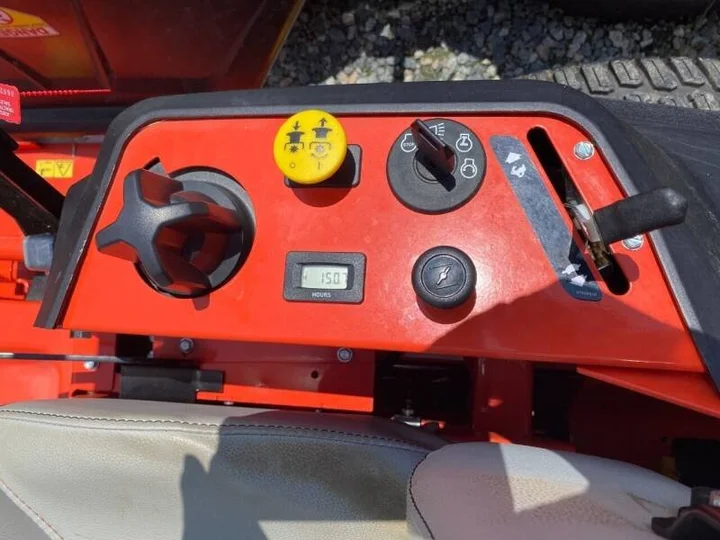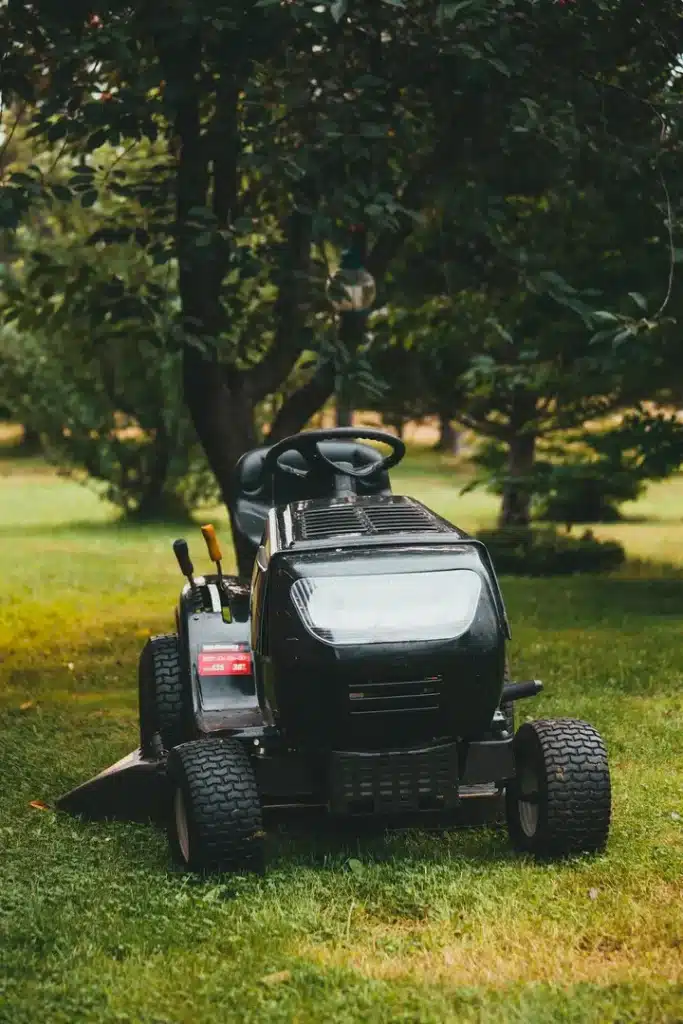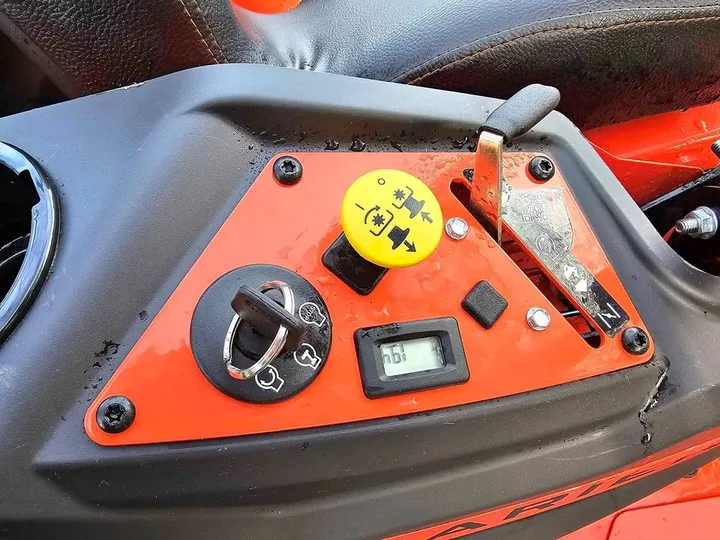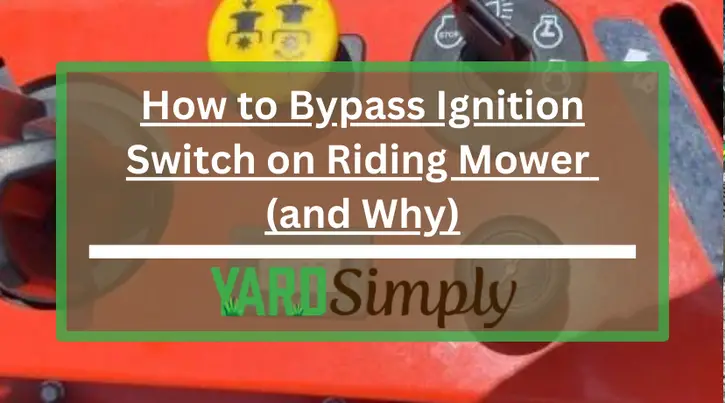According to a survey by Consumer Reports, nearly 30% of riding mower problems are related to the ignition system. This can be both frustrating and time-consuming to fix.
As a seasoned DIY enthusiast and writer in the field of home maintenance, I’ve seen my fair share of ignition switch issues on riding mowers. Overcoming these obstacles often requires a bit of ingenuity and a solid understanding of the mower’s electrical system.
When your mower refuses to roar to life, knowing how to bypass the ignition switch can be an invaluable skill. It can save you time and the cost of a service visit.
In the following discussion, I’ll walk you through the crucial steps to safely and effectively override a faulty ignition switch. I’ll also consider the nuances that ensure you don’t inadvertently damage your equipment.
So, if you’re curious about how to keep your lawn looking pristine even when your mower’s ignition switch throws a tantrum, stick around. I’ll share some key insights that just might get you back in the driver’s seat faster than you can say ‘start your engines’.
Quick Summary
- To bypass the ignition switch on a riding mower, you need to disconnect the battery, access the wiring harness, and use tools like wrenches and screwdrivers to create a direct circuit.
- Alternative starting methods for riding mowers include jump starting, solenoid jumping, hot wiring, and push starting for manual transmission models, each with its own risks and required expertise.
- Nearly 30% of riding mower problems are related to the ignition system, as reported by Consumer Reports, emphasizing the importance of understanding ignition-related issues.
- In my experience, while bypassing the ignition switch can be a useful skill, it’s essential to prioritize safety and consult professionals when in doubt.
Step by Step to Overriding the Ignition Switch
If you’re facing issues with the ignition switch of your riding mower and need to bypass it. Here are the key steps:
- Disconnecting the Mower’s Battery
- Locating the Ignition Switch
- Accessing the Wiring Harness
- Bypassing the Ignition Switch
- Testing the Bypassed Ignition Switch
Before we tackle the task of bypassing the ignition switch on our riding mower, let’s ensure we’ve got the right tools on hand.
- Set of Wrenches: To disconnect the battery terminals.
- Screwdriver: To access the ignition switch and wiring harness.
- Wire Strippers: For stripping and preparing wires for connections.
- Multimeter: To test for continuity and voltage in the wiring and switch.
- Insulated Wire Connectors: For making safe wire connections when bypassing the switch.
- Jumper Wires or a Screwdriver: For creating a bridge across the solenoid terminals, if using the solenoid jumping method.
- Protective Gear: Safety gloves and goggles to protect against electric sparks and debris.
Disconnecting the Mower’s Battery
- Ensure Electrical Safety: Before starting, prioritize safety by taking precautions against electric shocks. Wear appropriate protective gear like gloves and safety glasses.
- Perform a Voltage Check: Use a voltage meter to check the battery. Ensure the battery is inactive (no current flowing) to prevent unexpected electrical discharge.
- Inspect for Corrosion: Regularly inspect the battery for signs of corrosion, especially around the terminals. Corrosion can interfere with electrical connections.
- Clean the Terminals (if necessary): If you notice any corrosion or buildup on the terminals, clean them thoroughly. This ensures a good connection and prevents issues during the bypass.
- Disconnect the Battery: After confirming the battery is safe to handle and the terminals are clean, carefully disconnect the battery. Typically, you’ll remove the negative terminal first, followed by the positive terminal.
Finding the Ignition Switch

- Identify Potential Ignition Switch Locations: Understand that the ignition switch is commonly located either behind the dashboard or under the seat of the mower. These locations are chosen for durability and ease of access during maintenance.
- Consult the Mower’s Electrical Diagrams: Before proceeding, refer to your mower’s electrical diagrams. These diagrams can usually be found in the mower’s manual. They provide crucial information about the ignition system’s layout.
- Identify the Ignition Switch on the Diagram: Using the electrical diagrams, locate the exact position of the ignition switch. This step ensures that you are targeting the right component for your bypassing task.
- Inspect the Mower for the Ignition Switch: Based on the information from the diagrams, inspect the usual spots on your mower where the ignition switch could be mounted. Use your flashlight to help see in dark areas under the dashboard or the seat.
Gaining Access to the Wiring Harness
- Remove Dashboard Panel or Lift the Seat: Depending on the location of the ignition switch, carefully remove the dashboard panel or lift the seat to expose the mower’s wiring harness. Be methodical and gentle to avoid any damage.
- Conduct a Thorough Wiring Inspection: Once you have access to the wiring harness, inspect it closely. Look for any signs of wear, damage, or faults in the wiring. This is crucial for identifying any existing issues that might affect the bypass process.
- Clean the Connectors: Ensure that each connector in the wiring harness is free from corrosion and debris. Clean connections will help maintain a reliable circuit and prevent future electrical problems.
- Perform Circuit Testing with a Multimeter: Use a multimeter to test the circuits for continuity. This step is essential to ensure that the current flows correctly through the wiring and that there are no breaks or shorts in the circuit.
- Be Mindful of Harness Protection: During the inspection and testing process, take care not to stress or strain the wires. Protecting the integrity of the wiring harness is important for the mower’s overall electrical system.
- Note Any Faults for Repair: If you find any issues during your fault diagnosis, make a note of them. It’s important to address these repairs before proceeding with any attempt to bypass the ignition switch.
Bypassing The Switch
- Prepare for Jump Start Method: The jump start method involves bridging the connection usually made by the ignition switch. This is a common technique for bypassing the switch in emergency situations.
- Strip Necessary Wires: Use the wire strippers to carefully expose the ends of the wires you’ll be working with. Make sure you identify the correct wires based on your mower’s wiring diagram.
- Connect Wires with Insulated Connectors: Use insulated wire connectors to safely bridge the wires that are normally connected by the ignition switch. This will create a circuit that bypasses the switch.
- Consider Permanent Aftermarket Solutions (Optional): If you’re looking for a more permanent solution to bypass the ignition switch, explore aftermarket alternatives that offer keyless start capabilities. These systems might use a magnetic key or a coded signal to activate the mower.
- Solenoid Jumping for Quick Fix: For a quick and direct method, consider solenoid jumping. This method involves connecting the starter solenoid directly to the battery to energize the starter motor.
- Handle Tools and Wires Carefully: While performing the bypass, be very cautious to prevent electrical shorts or other safety hazards. Ensure that all connections are secure and handle tools with care.
- Test the Bypass: After completing the connections, test the bypass to see if the mower starts. Be prepared to disconnect quickly in case of any issues.
Learn More: How to Bypass Safety Switch on Zero Turn Mower
Testing on the Bypassed Ignition Switch
- Prepare Your Multimeter: Ensure your multimeter is in good working condition. This tool is essential for the testing process.
- Set Multimeter to Continuity Mode: Begin by setting your multimeter to the continuity test mode. This setting will help you check if the bypassed circuit is complete.
- Check for Circuit Continuity: Use the multimeter probes to test the continuity of the circuit that you’ve created by bypassing the ignition switch. If the circuit is complete, the multimeter will typically emit a tone or show a reading, indicating successful bypass and current flow.
- Switch to Voltage Measurement: Next, adjust your multimeter to measure voltage. This step is crucial for understanding if the correct voltage is reaching the starter solenoid.
- Test Voltage at the Starter Solenoid: While attempting to start the mower, measure the voltage at the starter solenoid. You’re looking for voltage readings that fall within the normal operating range for your mower’s model.
- Analyze the Readings: If the voltage readings are within the expected range, it indicates that power is reaching the starter solenoid properly, and your bypass of the ignition switch is effective.
- Assess Overall Functionality: After the electrical tests, attempt to start the mower to assess its overall functionality post-bypass. If the mower starts successfully, the bypass is working as intended.
Basics of a Riding Mower’s Ignition Switch

At the heart of every riding mower’s functionality lies its ignition switch, a critical component that controls the starting process. This switch is the gatekeeper of the mower’s electrical circuitry, playing a pivotal role in ignition functionality.
When I turn the key, it’s not just about firing up the engine; it’s about completing an electrical circuit that brings my mower to life.
Identifying a Malfunctioning Ignition Switch
- Recognizing Signs of a Failing Ignition Switch:
- Difficulty Turning the Key: Struggle or resistance when turning the key in the ignition.
- Intermittent Starting: The mower starts unpredictably or requires multiple attempts.
- Failure to Engage Electrical System: Complete lack of response when the key is turned, indicating no power is being transmitted.
- Diagnostic Steps:
- Check Connections and Wires: Inspect for any loose connections or damaged wires that could be impacting the ignition switch’s functionality.
- Continuity Test with Multimeter: Use a multimeter to test the ignition switch for continuity. Absence of continuity in positions where there should be is a strong indicator of a malfunctioning switch.
- Deciding on Replacement Options:
- Assessing the Severity of Failure: Determine the extent of the ignition switch issue.
- Choosing a Replacement Type: Depending on the mower model and the issue’s severity, options might include:
- Direct OEM Replacement: Opting for a manufacturer-approved switch.
- Universal Switch: Considering a universal switch if it’s compatible with the mower.
- Ensuring Compatibility: Verify that the chosen replacement is suitable for the mower’s electrical system to avoid safety risks and further damage.
Safety Tips and Precautions
- Understand the Risks: Acknowledge the dangers involved in tampering with electrical components of a riding mower, which can lead to injury or equipment damage.
- Know the Emergency Stops: Be familiar with the mower’s emergency stop mechanisms and ensure you can activate them quickly if necessary.
- Injury Prevention Priority: Always prioritize injury prevention and avoid taking shortcuts in safety measures.
- Use Protective Gear:
- Gloves: Wear gloves to protect your hands from sparks and sharp edges.
- Safety Goggles: Use safety goggles to shield your eyes from potential debris or sparks.
- Work in a Well-Ventilated Area: Ensure the workspace is well-ventilated to prevent hazards related to fumes.
- Assess Your Capabilities: Recognize the limits of your skills and knowledge. If a task seems beyond your expertise, do not hesitate to consult or hire a professional mechanic.
- Consult Authorized Personnel When Necessary: Professional mechanics have the training and experience to handle complex issues safely and efficiently.
- Consider the Cost-Benefit of Professional Help: Weigh the potential cost of a DIY mishap against the expense of professional services. Remember, investing in safety and expertise can prevent costly errors and accidents.
Read More: Danger of Zero Turn Mowers: The Hidden Facts
Other Ways to Start Your Riding Mower
- Jump Starting:
- Similar to jump-starting a car, this method involves using jumper cables to connect the mower’s battery to another vehicle’s battery.
- Caution is necessary to ensure correct cable connections and avoid sparks or short circuits.
- Solenoid Jumping:
- This technique involves bypassing the solenoid using a screwdriver or jumper wire.
- It requires a good understanding of the mower’s electrical system to correctly touch the appropriate terminals without causing damage.
- Hot Wiring:
- A more complex method that involves creating a direct connection between the battery and the ignition system.
- Recommended only for those with a thorough knowledge of the mower’s wiring system, as it can be risky.
- Clutch Trick (For Manual Transmission Mowers):
- Also known as push starting, this method involves putting the mower in gear, pushing it to gain momentum, and then quickly engaging the clutch to start the engine.
- Requires physical effort and timing but can be effective for manual transmission mowers.
Each of these methods carries its own set of risks and challenges. It’s essential to fully understand the process and potential dangers of each method before attempting to start the mower using these alternative techniques.
Safety should always be the top priority.
Pros and Cons of Overriding the Ignition Switch

When it comes to dealing with a malfunctioning ignition switch on a riding mower, overriding the switch can be a practical solution. However, it’s essential to weigh both the benefits and drawbacks of this approach.
Below is a balanced overview of the pros and cons:
Pros
- Enhanced Mechanical Understanding: Learning to bypass an ignition switch can deepen the owner’s understanding of their mower’s mechanics. This enhanced knowledge can lead to better maintenance and upkeep practices.
- Cost-Effectiveness: Opting to bypass the ignition switch can be a more economical solution compared to professional repair services. This DIY approach can save money in the short term.
- Emergency Utility: In situations where immediate use of the mower is necessary, and professional help is not readily available, knowing how to bypass the ignition switch can be extremely useful.
- Skill Development: The process of bypassing an ignition switch can serve as a valuable learning experience, enhancing one’s DIY repair skills. These skills can be transferable to other small engine repairs.
- Time-Saving: Bypassing the ignition switch can be a quick fix, providing an immediate solution without the wait associated with professional repair services.
Cons
- Safety Concerns: Bypassing an ignition switch can introduce safety risks, including the potential for electrical hazards or accidental mower start-up. Such risks are in alignment with safety guidelines from organizations like the CPSC.
- Warranty Issues: This type of modification can void the mower’s warranty. Without a valid warranty, any further malfunctions could lead to out-of-pocket repair costs.
- Risk of Improper Execution: If not done correctly, bypassing the ignition switch might lead to further damage to the mower’s electrical system. This could result in additional repairs and costs.
- Legal and Insurance Implications: Unauthorized modifications, such as bypassing an ignition switch, might have legal and insurance repercussions, particularly if they lead to accidents or injuries.
- Temporary Solution: Often, this method serves as a stopgap rather than a permanent fix, potentially overlooking the root cause of the ignition issue, which may recur later.
Our Verdict
In my experience, mastering the art of bypassing an ignition switch on a good riding mower can be a game-changer. It’s a skill that has saved me time and money, especially when dealing with those all-too-common ignition problems.
But let me be clear, this isn’t a task to take lightly. Safety is paramount, and I always ensure I’m well-equipped with the right tools and protective gear before diving in.
While I’ve found alternative starting methods like jump starting or solenoid jumping to be effective, I’m always mindful of the risks involved.
For those who aren’t as comfortable with such DIY fixes, I strongly recommend consulting a professional.
Remember, taking shortcuts can lead to more harm than good, and sometimes, calling in the experts is the best course of action. Stay safe and happy mowing!
Frequently Asked Questions
Is it legal to bypass the ignition switch on my riding mower if i own it?
I’m unsure if bypassing the ignition switch is legal. It might raise safety concerns, theft prevention issues, and legal repercussions. Also, I’d worry about personal liability if my actions aren’t within my ownership rights.
How does bypassing the ignition switch affect my riding mower’s warranty or insurance coverage?
I’m concerned that bypassing an ignition switch might void my warranty, breach my insurance policy, pose safety risks, and have legal implications, possibly even allowing unauthorized access to my equipment.
Can bypassing the ignition switch cause long-term damage to my riding mower’s electrical system?
Bypassing can lead to electrical risks, potentially causing starter damage. It might compromise wiring integrity, raise safety hazards, and create diagnostic issues that could affect my mower’s performance and longevity.
What are the environmental impacts of bypassing an ignition switch on a riding mower?
I’m considering the environmental impacts of tampering with machinery. Bypassing an ignition may lead to electrical risks, safety hazards, unauthorized access, added maintenance challenges, and raises ethical considerations about responsible equipment use.
Are there any specific brand or model considerations I should be aware of when attempting to bypass the ignition switch on my riding mower?
I’m checking for brand compatibility and model specificity before I start. I’ll also consider wiring differences, safety features, and follow the manufacturer guidelines to ensure I’m not compromising my mower’s functionality.


